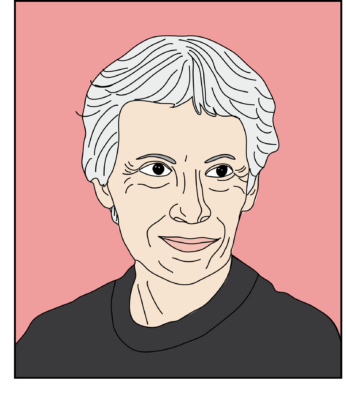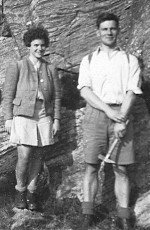
On a late summer day in September 1923, Janet Vida Watson was born. With a father working in palaeontology and a mother who did research in embryology until her marriage, Janet grew up with science all around her. She went to South Hampstead High School, known for its science teaching and continued her education in General Science at Reading University. She graduated in biology and geology in 1943, a first-class honour degree for both subjects.
She first started working at the National Institute for Research in Dairying. Here, she had to observe how chicken grew and what they ate. This was not exactly the career Janet had in mind, and she started to teach biology at Wentworth School. This was not entirely up her lane either, and she decided to become a geologist in 1945. After an outstanding recommendation from Professor H.L. Hawkins, she could start at Imperial College with her dream study Geology, finishing in 1947, again with excellent grades. It was during a mapping project in the Scottish Highlands that she really fell in love with the job, and her career in geology was born.
Janet’s PhD project started in 1947 under the supervision of Herbert Harold Read. She was taken as a student to study the migmatites in Sutherland, from which she published her first paper in 1948 (Watson 1948). It was during this time that Janet got truly comfortable with her speaking and writing gifts. Fellow students of the student societies would have her as her top-speaker and she would use her talent to clearly, precisely and persuasively convince and excite everyone about what she was talking about (Bowes 1985).

Janet in the field during her PhD candidacy. It is not clear if the man on the right is John Sutton or Don Bowe.
https://www.geoexpro.com/articles/2011/01/an-extraordinary-diverse-and-rewarding-career
Later during her PhD, she was set to study the Lewisian Complex in northern Scotland together with John Sutton, one of the other PhD candidates in Read’s team, and eventually her husband. She finished her PhD in 1949 after which she and John got married and went on a honeymoon to the Channel Islands. In her PhD thesis, which was published together with John’s in their famous 1951-paper (Sutton & Watson 1951), they propose that the Lewisian complex had suffered two deformation phases from two separate orogenic events. They used the igneous events to logically reconstruct the large amounts of time that are embedded in Precambrian basement. This approach became a common method in Precambrian geological studies and was exported to other areas on the planet, including Greenland. In 1954, Janet and John, were jointly awarded with the Lyell Fund given by the Geological Society of London for their work.
Interestingly, in 1957 a paper came out, about the structure of the Channel Island Sark, written by Sutton and Watson (Sutton & Watson 1957).
After her PhD, Janet continued her research as a Research Assistant at Imperial College for another 20 years. She specialized in Precambrian geology of Scotland, by doing fieldwork in outcrop areas including the Moine, Dalradian and Torridonian periods. She had an enormous enthusiasm for fieldwork and it is no surprise that she started to collaborate with the geologists from the British Geological Survey, amongst which was Dr. Jane Plant, a leading geochemist, to map the Outer Hebrides in 1960. Around the mid-60’s, she started to integrate isotope dating into her work, even though she would always remain a field geologist. The rocks in the field that she could see with her own eyes, she trusted more than the radiometric data of particles she couldn’t see (Bowes 1985).

Janet Watson, standing on the right, is the only female delegate attending the excursion to South Finland as part of the International Geological Congress, 1960.
https://www.geolsoc.org.uk/~/media/shared/images/library/archives/Women%202019/Watson%20%20officers.jpg?la=en
Janet was a very respected structural geologist. Her ability to communicate clear and precise messages in both written and spoken expositions made her important to both scientific contributions and administrative changes that happened during the 40 years she worked at Imperial College. However, her position as Research Assistant also withheld her from certain privileges her male-colleagues higher-up in the hierarchy had. Graham Park, who wanted to invite her as an External Examiner for the graduation of one of his doctoral students, had to convince the commission by showing them the Bigsby Medal statement that, despite her lower rank, she was the best candidate.
In 1973 Janet became a Senior Lecturer at Imperial College, the same year she was awarded the Lyell Medal. She then worked on studying the post-Caledonian evolution of Scotland including its influence of diagenesis on hydrothermal activity. In 1975 she got her own academic chair in Geology at Imperial College and expanded her interests to ore genesis and regional geochemistry. In 1979, the Royal Society of Edinburgh awarded her with the Clough Medal and in the same year she became an elected member of the Council of the Geological Society of London. From 1982-1984 she was the president of the Society, the first woman to ever hold that position.

Janet Watson as the President of the Geological Society, 1983
https://www.geolsoc.org.uk/~/media/shared/images/library/archives/Women%202019/Watson%20%20officers.jpg?la=en
Janet’s legacy continues today, not only with the major contributions she did in around 65 unique publications that advanced the Earth Sciences in the 20th Century, but also in the vast number of students whom she guided and inspired to pursue a career in geology. Former students remember her skill for asking fundamental questions and they appreciated her calm, but serious encouragement to become independent thinkers (Park 2009). Prof. Dr. Sudipta Sengupta, the first woman scientist in India to go to Antarctica as a geologist, was mentored by Janet herself, when she was doing her postdoctoral studies at Imperial College in the 70’s. She has fond memories of a field trip she joined, led by Janet, and says that ‘she was a pioneering structural geologist, who had contributed a lot to her field. She was for me and still is for many, a real inspiration for future female geologists.’
References
Janet Watson, 1948. Late sillimanite in the migmatites of Kildonan, Sutherland. Geological Magazine, 85, 149-162.
D.R. Bowes, 1985. Janet Watson – an appreciation and bibliography. From: Park, R.G. and Tarney, J. (eds), 1987, Evolution of the Lewisia and Comparable Precambrian High Grade Terrains, Geological Society Special Publication, No. 27, 1-5.
John Sutton & Janet Watson, 1951. The pre-Torridnian metamorphic history of the Loch Torrdon and Scourie areas in the north-west Highlands, and its bearing on the chronological classification of the Lewisian. Quarterly Journal of the Geological Society of London, 106, 241-307.
John Sutton and Janet Watson, 1957. The structure of Sark, Cannel Islands, Proceedings of the Geological Association of London, 68, 179-203.
Graham Park, 2009. Janet Vida Watson, FRS: an appreciation. Journal of the Geological Society, London, Vol. 166, 385-386.




